Here's how the top 100 largest US metros stack up for internet speed, price, and availability.
The State of Connectivity: The Most and Least Connected US Cities for Internet
A full 70% of Americans say affordable internet is “extremely important” to their daily lives. But with the federal government’s Affordable Connectivity Program scheduled to end in April, some folks will be left scrambling to get online.
Luckily, since 2022, the average U.S. internet speeds have improved by 44%, thanks in part to investments in fiber and 5G infrastructure expansion. To help Americans know where to find widespread internet access, we’ve determined the most (and least) connected cities in the United States.
Guide to this report:
We may earn money when you click our links.
The most and least connected American cities for internet
To figure out the most and least connected cities in the country, we conducted research to get stats on the following data points:
- Average download speeds
- Price per Mbps per metro
- Fiber availability percentage
- Number of available internet providers
- Number of public Wi-Fi hotspots
We then analyzed this data to get our top ten most connected cities in the U.S. To learn more, check out our Methodology section.
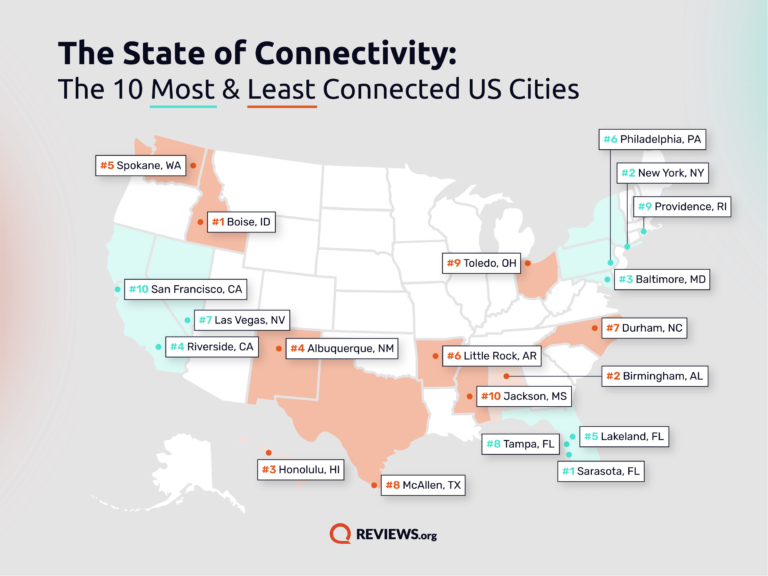
FYI: Our calculations cover the whole metro area of each city, not just the cities themselves.
#10 most connected city: San Francisco, CA
San Francisco has a lot of pizza and a lot of internet, and it’s fast (the internet, not the pizza). The high average speed is probably due to more than half the city having access to fiber internet.
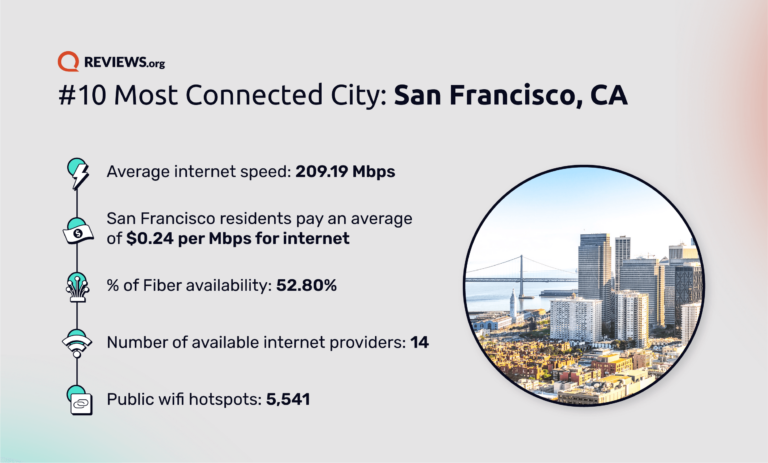
San Francisco internet stats:
- The average internet speed is 209.19Mbps.
- San Francisco residents pay an average of $0.24 per Mbps for internet. That’s surprisingly cheap for the über-expensive Bay Area.
- 80% of San Francisco has fiber availability—no surprise with Silicon Valley-ites around.
- 14 internet providers are available in San Francisco.
- 5,541 public Wi-Fi hotspots are scattered throughout.
#9 most connected city: Providence, RI
In Providence, internet access isn’t simply a matter of, well, providence. Two-thirds of the state has fiber availability, there are over 1,000 Wi-Fi hotspots available publicly across the city, and a total of 12 internet providers offer service. Not bad for the capital of the smallest state.
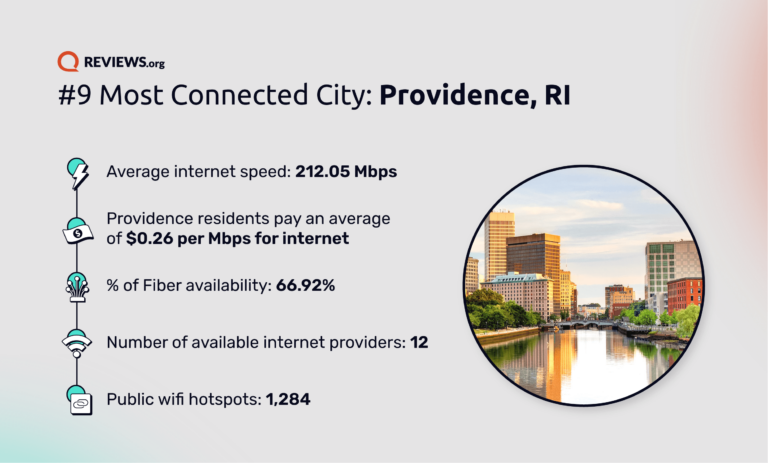
Providence internet stats:
- The average internet speed is 212.05Mbps, which is especially useful if you’re a student at Brown.
- Providence residents pay an average of $0.26 per Mbps for internet.
- 92% of Providence has fiber availability.
- 12 internet providers are available in Providence.
- 1,284 public Wi-Fi hotspots are scattered throughout.
#8 most connected city: Tampa, FL
Tampa loves its pirates, but not even legendary buccaneer José Gaspar would need to steal internet in this colorful city. It’s just too accessible, with 2,000+ public Wi-Fi hotspots and fast fiber available in over half the metro.
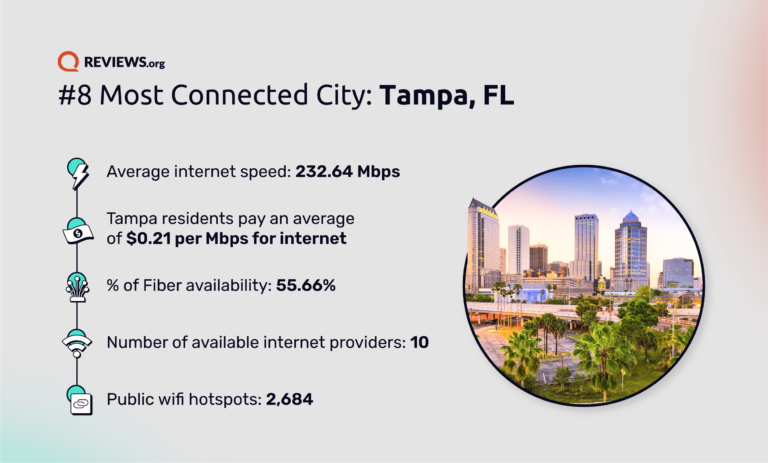
Tampa internet stats:
- The average internet speed is 232.64Mbps.
- Tampa residents pay an average of $0.21 per Mbps for internet.
- 66% of Tampa has fiber availability.
- 10 Wi-Fi providers are available in Tampa.
- 2,684 public Wi-Fi hotspots are scattered throughout (and some of them are in amusement park Busch Gardens).
#7 most connected city: Las Vegas, NV
Viva Las Vegas, and viva Las Vegas internet! At 248.15Mbps, Vegas’s internet average speed is the second-highest on our top-ten list. In contrast, it has the lowest fiber availability percentage out of the top ten—less than 50%. But to be fair, you probably don’t need a fiber connection when watching John Mulaney’s comedy show or playing slots.
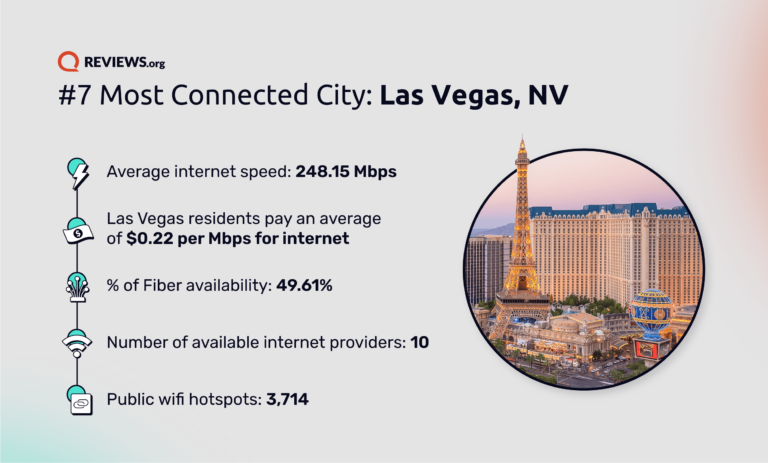
Las Vegas internet stats:
- The average internet speed is 248.15Mbps—plenty fast enough for you to livestream your wedding on the Strip.
- Las Vegas residents pay an average of $0.22 per Mbps for internet.
- 61% of Las Vegas has fiber availability.
- 10 internet providers are available in Las Vegas.
- 3,714 public Wi-Fi hotspots are scattered throughout.
#6 most connected city: Philadelphia, PA
Philadelphia is famously the Birthplace of Liberty, though it’s into a whole new kind of freedom these days: the freedom of internet connectivity. Fiber internet is available in nearly two-thirds of the city, and there are 13 ISPs to choose from.
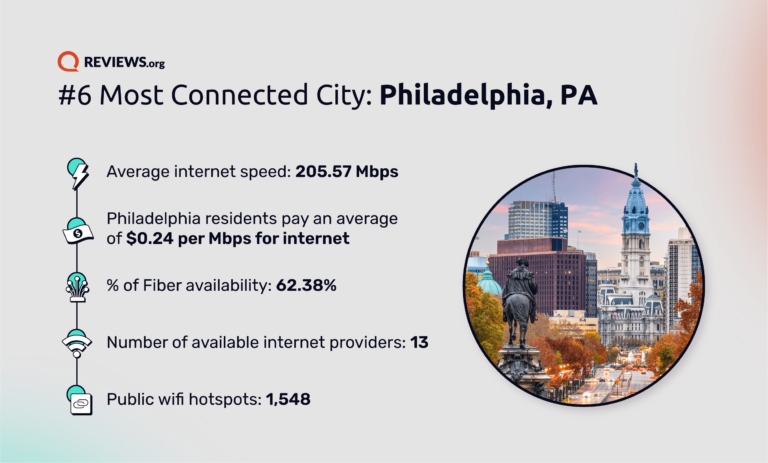
Philadelphia internet stats:
- The average internet speed is 205.57Mbps.
- Philadelphia residents pay an average of $0.24 per Mbps for internet, which isn’t a fantastic bargain but leaves plenty of money for cheesesteaks.
- 38% of Philadelphia has fiber availability.
- 13 internet providers are available in Philly.
- 1,548 public Wi-Fi hotspots are scattered throughout.
#5 most connected city: Lakeland, FL
Come to Lakeland for the Frank Lloyd Wright architecture; stay for the internet accessibility. Internet is both plentiful and inexpensive ($0.19 per Mbps!) in this beautiful, lake-filled city.
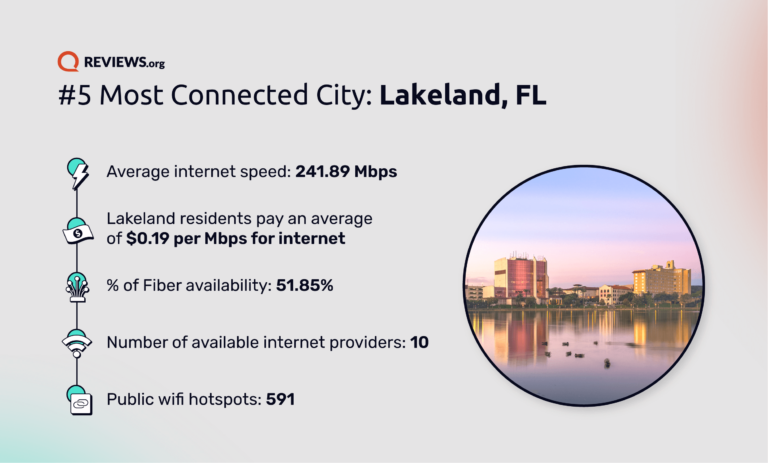
Lakeland internet stats:
- The average internet speed is 241.89Mbps, more than enough to learn on Wikipedia that Queen Elizabeth II once gifted two mute swans to the city.
- Lakeland residents pay an average of $0.19 per Mbps for internet.
- 85% of Lakeland has fiber availability.
- 10 internet providers are available in Lakeland (and 9 Publixes—the chain was founded there).
- 591 public Wi-Fi hotspots are scattered throughout.
#4 most connected city: Riverside, CA
Continuing with cities named for bodies of water, Riverside is the next most-connected city. The city is no stranger to fiber internet or dietary fiber (due to its booming citrus industry) and has approximately one public hotspot for every hundred residents.
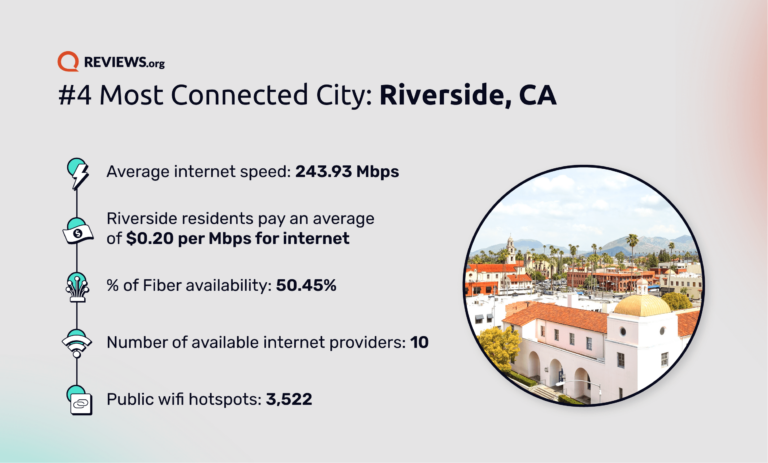
Riverside internet stats:
- The average internet speed is 243.93Mbps.
- Riverside residents pay an average of $0.20 per Mbps for internet.
- 45% of Riverside has fiber availability—you have a 50/50 chance of finding a place with symmetrical speeds to upload photos of the Mission Inn.
- 10 internet providers are available in Riverside.
- 3,522 public Wi-Fi hotspots are scattered throughout.
#3 most connected city: Baltimore, MD
Quoth the raven, “Baltimore has great internet connectivity!” While Baltimore’s internet isn’t the fastest or cheapest on our list, you have 14 different providers to choose from, and fiber internet is available at about two-thirds of addresses.
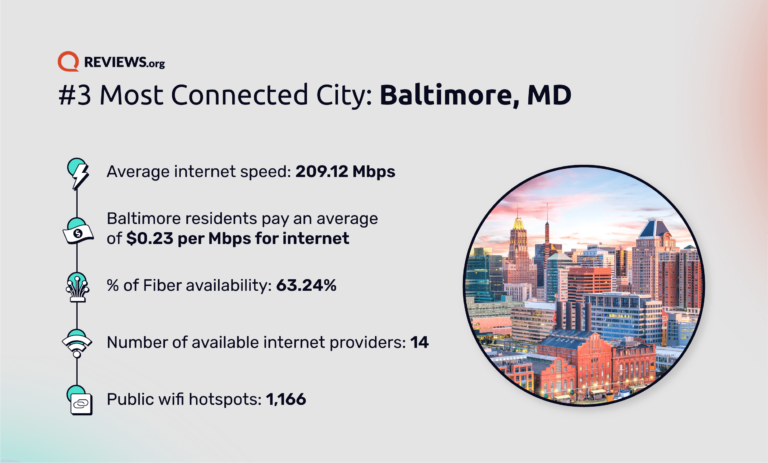
Baltimore internet stats:
- The average internet speed is 209.12Mbps.
- Baltimore residents pay an average of $0.23 per Mbps for internet.
- 24% of Baltimore has fiber availability.
- 14 internet providers are available in Baltimore.
- 1,166 public Wi-Fi hotspots are scattered throughout. Maybe you’ll find one by your favorite all-you-can-eat crab spot!
#2 most connected city: New York City, NY
New York is a city of dreams, but available internet isn’t one of those dreams—it’s a reality. Unsurprisingly, the Big Apple has the highest number of public Wi-Fi hotspots on our top ten list. It’s also tied with Baltimore for most internet providers.
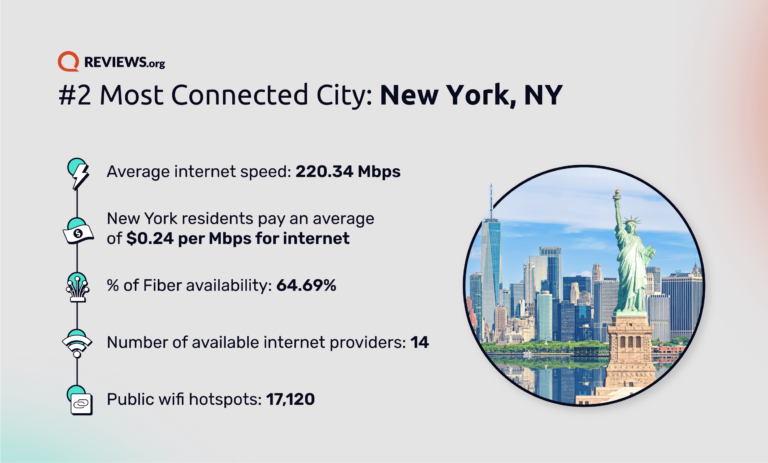
New York internet stats:
- The average internet speed is 220.34Mbps.
- New York residents pay an average of $0.24 per Mbps for internet.
- 69% of New York has fiber availability. We’re a little surprised it’s not higher.
- 14 internet providers are available in New York.
- 17,120 public Wi-Fi hotspots are scattered throughout.
#1 most connected city: Sarasota, FL
And the number one most connected city is surprise champion, Sarasota! Although it has a modest population, Sarasota has the fastest average internet speed in the top ten and the cheapest average internet cost.
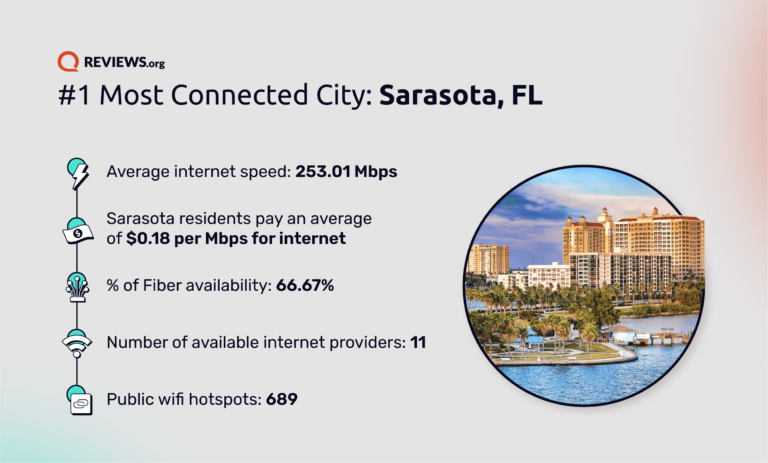
Sarasota internet stats:
- The average internet speed is 253.01 Mbps.
- Sarasota residents pay an average of $0.18 per Mbps for internet, so residents can spend more money at the local opera, ballet, and circus museums.
- 67% of Sarasota has fiber availability.
- 11 internet providers are available in Sarasota.
- 689 public Wi-Fi hotspots are scattered throughout.
If you’re curious about our complete list of connected cities, look no further. Here’s our connectivity ranking of the top 100 metros (based on population).
Overall city connectivity rank
The importance of fiber
So what’s the deal with fiber? While any internet can get you online, and many cable internet infrastructures include fiber-optic cables, 100% fiber is the fastest and most stable connection. Unfortunately, in some cases, it’s less affordable than other options, especially if you have a low income. But as fiber becomes more prevalent, prices will likely decrease.
The top 100 metro areas on our list have a fiber availability average of 42%. The least connected American cities on our list have less fiber availability than the national average, except Harrisburg, Pennsylvania.
Best fiber providers in the US
Methodology
We analyzed HighSpeedInternet.com Speed Test Tool results between January 2023 and January 2024 to rank the most and least connected cities. We then ranked each of the top 100 U.S. metros on six factors to find the most (and least) connected U.S. cities.
We normalized each measure on a 0–1 scale, with 1 corresponding to the measurement that would most positively affect the final score and 0 corresponding to the measurement that would most negatively affect the final score. Then we added together these adjusted measurements with the weights mentioned below to get a score of 100.
Each metro was ranked based on these factors:
- Average download speed in metro area (30%): A faster speed positively impacts the score.
- Price per Mbps per metro (30%): A lower price positively impacts the score.
- Percent of fiber availability within the metro area by zip codes (20%): A higher percentage positively impacts the score.
- Number of available internet providers within metro area (10%): A higher number of providers positively impacts the score.
- Number of available public Wi-Fi hotspots (5%): A higher number of available public Wi-Fi hotspots positively impacts the score.
- Percent of 5G home internet availability within metro area by zip codes (5%): A higher percentage positively impacts the score
Related Articles



